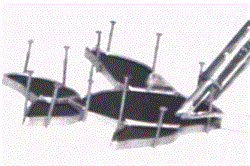|
|
|
Here's how you got here:
|

|
Soldering in the Lead Came Method
 STEP ONE
STEP ONE
APPLY THE FLUX. (See our "Chemicals, Consumables and Notions" section.) There are several varieties of fluxes available. Lead came does not require a strong flux, so I always settle for for a very mild flux, such as a fluxing gel. Whichever flux you choose, it will be sufficient for lead came work. The flux removes the oxides from the surface of the lead so that the solder can fuse to it. (If you did not use a flux, the solder would lay on the surface of the lead in droplets, and after they cooled, you could brush them off.)
I apply the fluxing gel with a flux brush onto the joints (intersections) of the lead which will be soldered.
STEP TWO
I then plug in my iron and wait for it to heat up. I test it from time to time until it is hot enough to melt a piece of solder being held against the tip. When this temperature has been reached, I unwind about 6 inches of solder from the roll and, holding the iron in one hand and the solder in the other, touch them together about 1/4" above the first joint I wish to solder. I allow a bit of solder to melt onto the tip, and then transfer the melted solder onto the joint rapidly, and just as rapidly, remove the iron from the joint. The tip of the iron should stay on the surface of the lead just long enough to heat the lead and transfer the solder to it. At 800-1000 degrees, it doesn't take long to heat a piece of small lead came, so don't dally. After a few sessions you will notice that a rhythm develops, and soldering will become easy.
I unplug the iron and remove the nails holding the project in position. I then wipe off the excess flux with a piece of paper towel, turn the project over and apply flux onto the unsoldered side. (There is no need to hold the project in place with nails.) I proceed as before, and solder the second side.
|
|